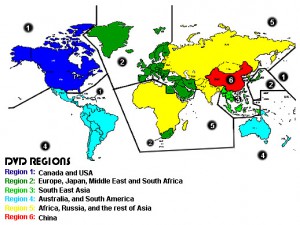Revisiting Region Codes
 This post is part of a partnership with the International Journal of Cultural Studies where authors of newly published articles extend their arguments here on Antenna.
This post is part of a partnership with the International Journal of Cultural Studies where authors of newly published articles extend their arguments here on Antenna.
There is, and always has been, a fundamental disconnect between digital media’s supposedly democratizing effects and the disconnections, delays, and prohibitions that actually characterize the global media environment. For instance, many around the world still feel the “digital distance” that comes with an inability to access films, songs, television programs, games, or other entertainment media experiences that remain out of reach. The DVD region code, developed and implemented in the mid-1990s, was instrumental in maintaining this distance.
Born out of complex, years-long standard-setting debates among film studios, consumer electronics manufacturers, and the computing industry, the region code gave the lie to the idea that digital technologies would necessarily ease global connectivity. By carving up the world into six geographic “regions,” with DVDs from one region unable to play on the DVD players of another, region codes actually attempted to retain global media’s disjunctive flows.
To this end, region codes represented a way for home video industries (and particularly the Hollywood studios) to segment and regionalize their distribution markets. And, of course, they did so in ways that privileged certain territories and markets over others—a logic most obviously apparent in the numerical ranking of the regions. Even a cursory glance at the region code map indicates that territories were grouped through their possible exploitation as markets as much as (or more than) geographic or cultural proximity. Of course, the relative prominence of region-free DVDs and the ease of burning and circulating unauthorized copies meant that region codes worked only partially to maintain these borders of distribution. Region codes could be particularly frustrating to diasporic viewers and cinephiles, who for various, obvious reasons would want access to DVDs from across borders. So, region-free players became quite common.
So, why is the DVD still an important element of media culture–and media studies–in 2014? Well, in spite of pronouncements of the DVD’s death, it’s very much alive. A recent poll showed that DVD and Blu-ray players are still the most commonly owned media devices in American households. Even if, for some, these players are collecting dust, they have not merely disappeared. Furthermore, in many territories around the world, the technology is still key to formal and informal film distribution networks. The fact is, any media technology has a far more complicated lifespan than we might imagine if we simply follow industry logic. As Paul Benzon has recently argued, rather than taking the DVD as obsolete, we might behold its “complex and conflicted timeline of technological change shaped by interdependence among innovation, obsolescence, residuality, reproduction, and reuse.” The suggestion that the DVD will be (or has been) wholly replaced by Blu-ray and streaming video is one that comes with classist and Western-focused assumptions.
But even for those who have already consigned the DVD to the scrap heap, regional lockout is still a common user experience. Streaming music platforms like Spotify and Pandora are only available in some regions. Likewise, VOD platforms like Netflix and the BBC iPlayer are geoblocked, and users take various measures to get past these hurdles. Although other forms of regional incompatibility existed before the DVD (like the PAL/NTSC/SECAM color television standards), the DVD region code represented a pioneering moment in the intentional, conscious installation of regional control mechanisms through DRM. Through geoblocking and IP address detection systems, this logic is present in today’s global media cultures.
For more on the DVD region code’s development, and its implications for global home video distribution and technological standardization, I invite you to read my new International Journal of Cultural Studies piece on the subject, entitled “The DVD Region Code System: Standardizing Home Video’s Disjunctive Global Flows.” To correspond with this post, the journal has agreed to make the article open access for three months.


